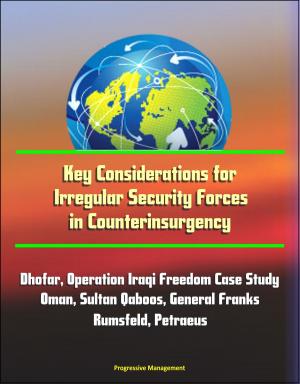Air Force Doctrine Document 3-13: Information Operations, Network Warfare, Electronic Warfare (EW), Information, Air and Space Superiority, Integrated Control Enablers
Nonfiction, History, Military, Strategy| Author: | Progressive Management | ISBN: | 9781476127460 |
| Publisher: | Progressive Management | Publication: | April 16, 2012 |
| Imprint: | Smashwords Edition | Language: | English |
| Author: | Progressive Management |
| ISBN: | 9781476127460 |
| Publisher: | Progressive Management |
| Publication: | April 16, 2012 |
| Imprint: | Smashwords Edition |
| Language: | English |
This Air Force Doctrine Document (AFDD) establishes doctrinal guidance for information operations (IO). The Air Force carries out information operations to support national and military objectives. The term "information operations" applies across the range of military operations from peace to war to reconstitution. During crisis or conflict, warfighters conduct information operations against an adversary. However, even when the United States is at peace, the Air Force is fully engaged, conducting IO on a daily basis. For example, because of the increasing dependence on information and the global information environment, the Air Force may be vulnerable to network attack, and so conducts network defense around the clock.
Information has long been a key part of human competition—those with a superior ability to gather, understand, control, and use information have always had a substantial advantage on the battlefield. From the earliest recorded battles to the most recent military operations, history is full of examples of how the right information at the right time has influenced military struggles. The Air Force recognizes the importance of gaining a superior information advantage—an advantage obtained through information operations (IO) fully integrated with air and space operations. Today, gaining and maintaining information superiority are critical tasks for commanders and vital elements of fully integrated kinetic and nonkinetic effects-based operations. Information operations are conducted across the range of military operations, from peace to war to reconstitution. To achieve information superiority, our understanding and practice of information operations have undergone a doctrinal evolution that streamlines the focus of IO to improve the focus on warfighting.
The new framework of information operations groups the capabilities of influence operations, electronic warfare operations, and network warfare operations according to effects achieved at the operational level. Each of these capabilities consists of separate and distinct sub-capabilities that, when combined and integrated, can achieve effects greater than any single capability. Integrated Control Enablers (ICE) is a new term used to define what was formerly expressed as information-in-warfare, or IIW. As our understanding of IO has advanced we have come see that ICE are not IO, but rather the "gain and exploit" capabilities that are critical to all air, space, and information operations. This new framework reflects the interactive relationship found between the defend/attack and the gain/exploit capabilities in today's Air Force.
Air Force doctrine recognizes a fully integrated spectrum of military operations. Information operations, like air and space operations, ought to be effects-based. Both air and space operations can support and leverage information operations, just as information operations can support and leverage both air and space operations. Through the horizontal integration of air, space, and IO, we will be able to fully realize the potential of air and space power for the joint force.
Contents: Chapter One - The Nature Of Information Operations * Chapter Two - Influence Operations * Chapter Three - Network Warfare Operations * Chapter Four - Electronic Warfare Operations * Chapter Five - Information Operations Planning And Execution * Chapter Six - Integrated Control Enablers * Chapter Seven - Education And Training
This Air Force Doctrine Document (AFDD) establishes doctrinal guidance for information operations (IO). The Air Force carries out information operations to support national and military objectives. The term "information operations" applies across the range of military operations from peace to war to reconstitution. During crisis or conflict, warfighters conduct information operations against an adversary. However, even when the United States is at peace, the Air Force is fully engaged, conducting IO on a daily basis. For example, because of the increasing dependence on information and the global information environment, the Air Force may be vulnerable to network attack, and so conducts network defense around the clock.
Information has long been a key part of human competition—those with a superior ability to gather, understand, control, and use information have always had a substantial advantage on the battlefield. From the earliest recorded battles to the most recent military operations, history is full of examples of how the right information at the right time has influenced military struggles. The Air Force recognizes the importance of gaining a superior information advantage—an advantage obtained through information operations (IO) fully integrated with air and space operations. Today, gaining and maintaining information superiority are critical tasks for commanders and vital elements of fully integrated kinetic and nonkinetic effects-based operations. Information operations are conducted across the range of military operations, from peace to war to reconstitution. To achieve information superiority, our understanding and practice of information operations have undergone a doctrinal evolution that streamlines the focus of IO to improve the focus on warfighting.
The new framework of information operations groups the capabilities of influence operations, electronic warfare operations, and network warfare operations according to effects achieved at the operational level. Each of these capabilities consists of separate and distinct sub-capabilities that, when combined and integrated, can achieve effects greater than any single capability. Integrated Control Enablers (ICE) is a new term used to define what was formerly expressed as information-in-warfare, or IIW. As our understanding of IO has advanced we have come see that ICE are not IO, but rather the "gain and exploit" capabilities that are critical to all air, space, and information operations. This new framework reflects the interactive relationship found between the defend/attack and the gain/exploit capabilities in today's Air Force.
Air Force doctrine recognizes a fully integrated spectrum of military operations. Information operations, like air and space operations, ought to be effects-based. Both air and space operations can support and leverage information operations, just as information operations can support and leverage both air and space operations. Through the horizontal integration of air, space, and IO, we will be able to fully realize the potential of air and space power for the joint force.
Contents: Chapter One - The Nature Of Information Operations * Chapter Two - Influence Operations * Chapter Three - Network Warfare Operations * Chapter Four - Electronic Warfare Operations * Chapter Five - Information Operations Planning And Execution * Chapter Six - Integrated Control Enablers * Chapter Seven - Education And Training















